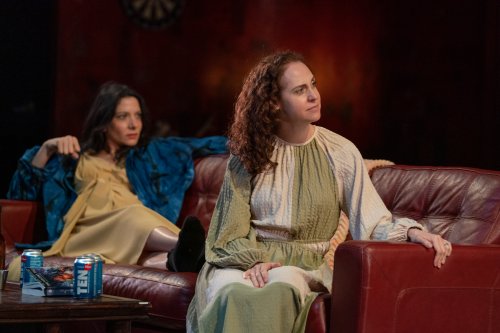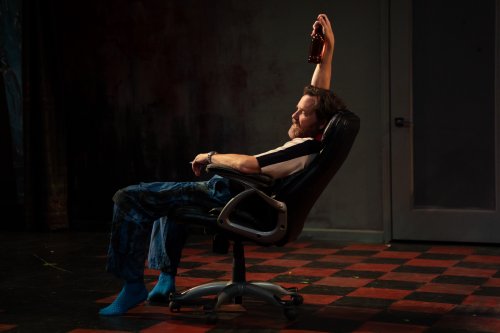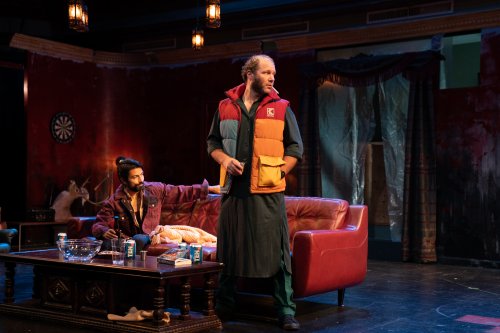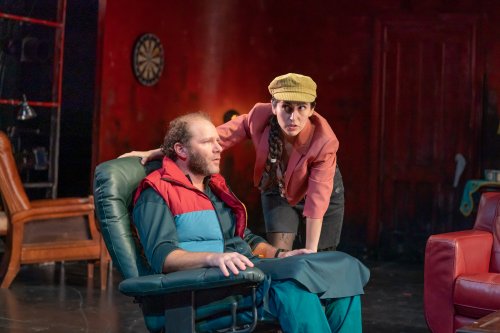The Winter’s Tale (Bedlam)
Bedlam’s modern dress version, of one of Shakespeare late plays, a somewhat updated interpretation, complicates the plot by using only seven actors to tell a fairy tale-like story.

Lisa Birnbaum as Hermione and Katie Hartke as Paulina in a scene from the Bedlam production of William Shakespeare’s “The Winter’s Tale” at the Irondale Center (Photo credit: Ashley Garrett)
[avatar user=”Victor Gluck” size=”96″ align=”left”] Victor Gluck, Editor-in-Chief[/avatar]
Bedlam, the experimental theater group, either gets it all right or all wrong. Sense and Sensibility, Pygmalion and The Crucible are among their smash hits that reinvented well-known texts. Currently they are performing two classics, William Shakespeare’s The Winter’s Tale and Henrik Ibsen’s Hedda Gabler, in repertory on the same set at the Irondale Center in downtown Brooklyn. Unfortunately, The Winter’s Tale must be considered one of their failures.
Many of Bedlam’s productions have used small casts with most of the actors playing more than one role. In the case of The Winter’s Tale, not one of Shakespeare’s more often produced plays, the casting uses so few actors that the play becomes confusing and difficult to follow, and a great many characters and much dialogue has necessarily been cut. In one head-scratching scene, Elan Zafir is required to play King Polixenes and his son Prince Florizel at the same time. While the sets and costumes are modern, with the Shakespeare poetry sacrificed to sound like contemporary speech, the characters are still referred to as “King Leontes” and his wife “Queen Hermione.” As the setting by John McDermott looks like three rooms in a frat house, one wonders why the Royal Family of Sicilia would be living in such shabby quarters and continually guzzling beer in the palace.
In the second half of the production which is set in the kingdom of Bohemia, two characters, the con-artist peddler Autolycus and the naïve Young Shepherd (also referred to as Clown), pretend to be a recording singer and a record producer, switch to contemporary slang, and have a conversation about Whitney Houston and Elvis Presley in a scene either ad-libbed, improvised or newly scripted. Unfortunately, as this is the only such scene in the production, it shatters the mood of Shakespeare’s text and setting. The updating of the decor, costumes and some of the language does nothing to help explain or elucidate this 1623 play.

Eric Tucker as Leontes in a scene from the Bedlam production of William Shakespeare’s “The Winter’s Tale” at the Irondale Center (Photo credit: Ashley Garrett)
The Winter’s Tale is a strange, unclassifiable play. Literary critics cannot decide if this play is a comedy, a late romance or one of Shakespeare’s problem plays. Much of it even fits the definition of an Elizabethan pastoral. It is also unusual in that 16 years go by between the first three acts and the last two causing it to be referred to as a “broken backed play,” splitting into two very different parts, a winter section and a summer section. There is a growing feeling that the play is an allegory of the fate of Queen Anne Boleyn and Princess Elizabeth (later Queen Elizabeth I) here with a happy ending. Elizabethan audiences would have had no trouble reading this into the story as the doomed queen had been beheaded only 90 years earlier and Queen Elizabeth I had only died 20 years before, certainly in common British memory.
The Winter’s Tale begins in the court of Bohemia where King Leontes has been hosting his childhood friend, King Polixenes of Bohemia, for the last nine months. When Polixenes begs off saying he wants to return home to see his young son, refusing Leontes’ requests that he stay on, Leontes asks his wife Hermione, pregnant with their second child, to beg him to remain. When Polixenes bows to Hermione’s pleading, Leontes becomes insanely jealous and accuses his wife of being unfaithful and assumes that her unborn child is not his. He orders Camillo, a Sicilian lord, to poison Polixenes but instead Camillo and Polixenes flee to Bohemia.
Leontes now throws his wife in prison and sends messengers to the Oracle at Delphos to confirm his suspicions. When a baby daughter is born to the incarcerated Hermione, her loyal friend Paulina takes the baby to Leontes but he had hardened his heart against the child and orders her husband Lord Antigonus to abandon it in a desolate place. When the message from the Oracle reports that Hermione and Polixenes are both innocent, that the child is that of Leontes, and that he will have no heir until his lost daughter is found, he refuses to believe it. At this juncture, news is received that Leontes’ son Mamillius has died by an illness brought on by the accusations against his mother and Hermione collapses. She is taken away by Paulina who later reports that the queen is dead. Bereft of queen, heir and daughter, Leontes vows to spend his days atoning.

Shaun Taylor-Corbett as Antigonus and Elan Zafir as King Polixenes in a scene from the Bedlam production of William Shakespeare’s “The Winter’s Tale” at the Irondale Center (Photo credit: Ashley Garrett)
The play then switches to the coast of Bohemia. Antigonus leaves the baby on the shore with the name Perdita (meaning “lost”) attached to her blanket, but in the strangest stage direction in all of Shakespeare, he is pursued and eaten by a bear. Sixteen years go by. Adopted by an Old Shepherd and his son, Perdita, now a shepherdess, has grown up to be a beautiful young girl, capturing the eye of Prince Florizel, son of King Polixenes. He has wooed her in disguise as a shepherd named “Doricles.”
When Camillo requests to return to Sicilia, Polixenes tells him about his problem with his son and the two of them attend the Old Shepherd’s sheep-shearing festival. The king reveals himself and orders his son never to see Perdita again, threatening the Old and Young Shepherd with violent punishment. With the help of Camillo, Perdita and Florizel flee to Sicilia with Polixenes in hot pursuit. As this is a comedy, all comes out happily at the end including the restoration of the supposedly dead Hermione to Leontes in one of those fairy tale denouements.
Eric Tucker’s knockabout production tears at the fabric of this delicate, pastoral play. The winter/summer dichotomy is never made clear here except that in the second half the costumes are sportier and there is less furniture visible. While the play is usually staged today as a psychological study in the effects of jealousy, the violent game played by Leontes and Polixenes that opens the play only seems to suggest toxic masculinity and competitiveness rather than what Shakespeare has called elsewhere “the green-eyed monster.” Having the Lord Camillo played by a woman is rather confusing in this context as she is always referred to as a lord while other characters are not entirely identified. The scene in which Polixenes simultaneously plays his own son is clear but pointless. If this is meant to be humorous, it fails to trigger all but embarrassed laughter.

Elan Zafir as King Polixenes and Karen Alvarado as Camillo in a scene from the Bedlam production of William Shakespeare’s “The Winter’s Tale” at the Irondale Center (Photo credit: Ashley Garrett)
As most of the actors play at least two roles, it is as though they decided to take one tack for each character. Dressed in an orange track suit throughout in Daniele Tyler Mathews’ contemporary garb, director Eric Tucker is rather one dimensional as a violent King Leontes, while his Old Shepherd is a bit more nuanced as a wise old man. As Queen Hermione, Lisa Birnbaum is a bit shrill while her Perdita is more than a little childish and simple. As Paulina, Katie Hartke is forceful and authoritative. Shaun Taylor-Corbett is negligible in the small role as her husband Antigonus but hilariously over the top as the swindler and thief Autolycus in the second half. Although it is unclear who Mike Labbadia plays in the Sicilia scenes, he is irrepressible as the Clown/Young Shepherd in the Bohemian section. Karen Alvarado as the Lord Camillo is rather retiring as a wise counselor. In the dual role of King Polixenes and his son Prince Florizel, Elan Zafir is dour in the first case and mannered in the second.
In the past, Bedlam’s reinventions have revealed or uncovered something new in the plays they have staged. This Winter’s Tale only seems to make things more complicated. The use of a company of only seven actors is here reductive, rather useful. Anyone unfamiliar with the play will have trouble with the double casting. It is only to be hoped that will Bedlam find its way back to elucidating classic texts that have become musty with age. At three hours and ten minutes this version of Shakespeare’s The Winter’s Tale feels long without any payoff while the physical production suggests royals down on their luck.
The Winter’s Tale (in repertory with Hedda Gabler: October 5 – November 20, 2022)
Bedlam
Irondale Center, 85 South Oxford Street, in Brooklyn
For tickets, visit http://www.ci.ovationtix.com/33875
For more information, visit http://www.bedlam.org
Running time: three hours and ten minutes with one intermission






Leave a comment